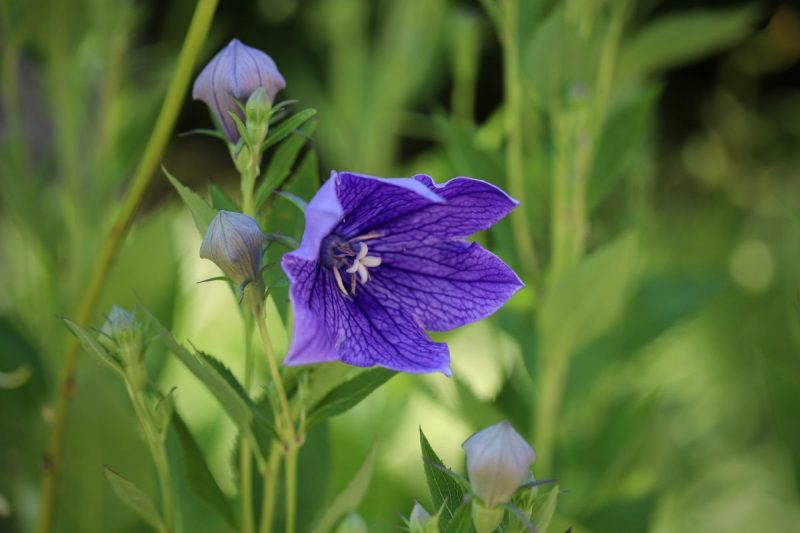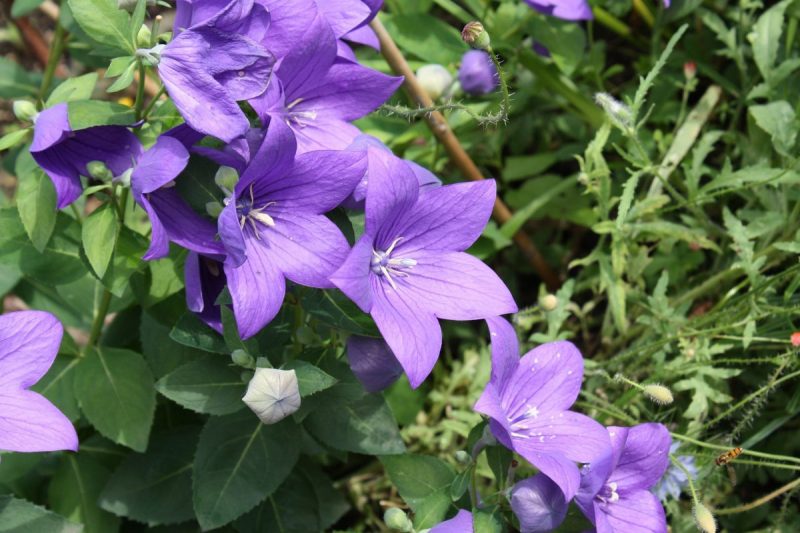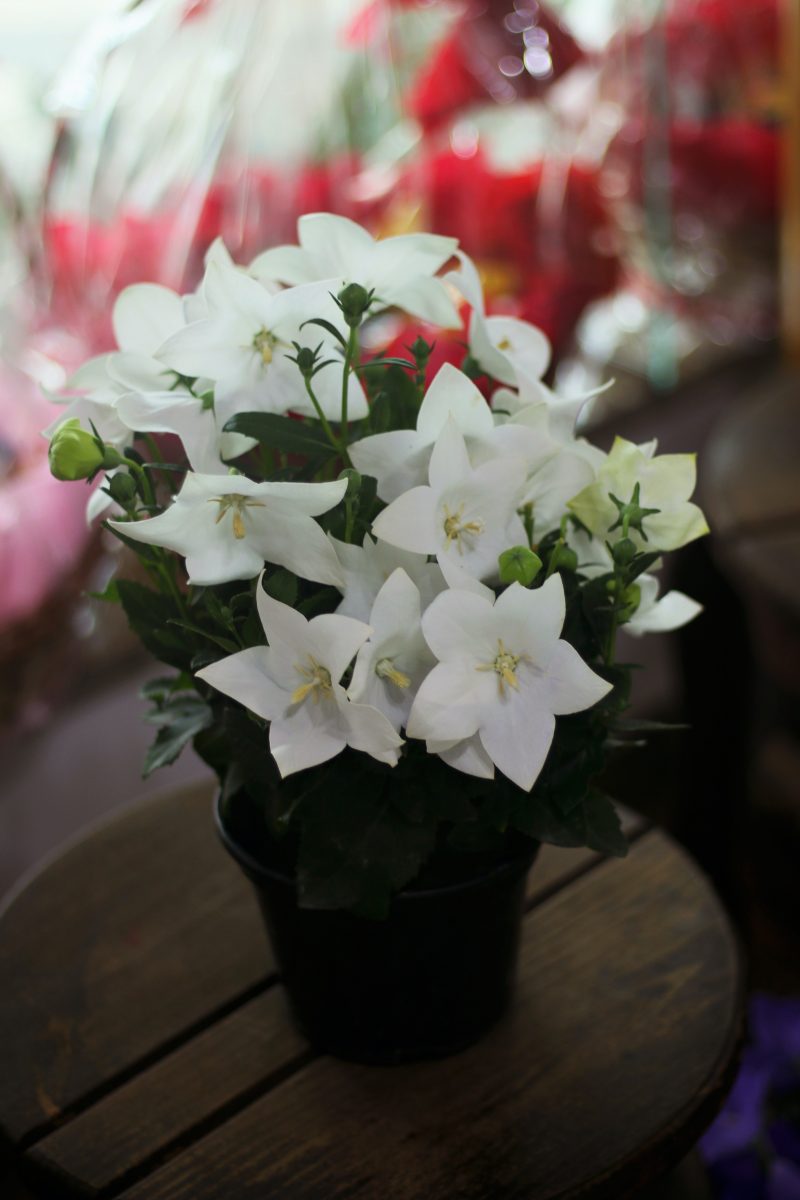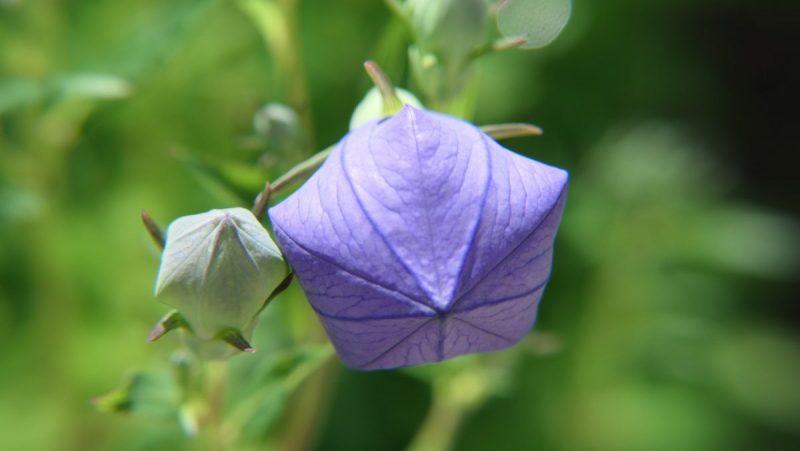Balloon flower, planting guide and care work

Balloon flower (Platycodon grandiflorus) is a perennial plant, a member of the Campanulaceae family, originating in China, Korea, Japan and Russia. It is a decorative plant with bell-like flowers and balloon-like buds. The flowers are composed of 5 blue-violet petals, and some varieties may have white or pink petals. The plant has a compact growth, reaching up to 60 cm in height. The leaves are oval, lanceolate, with serrated edges, dark green-colored.
The balloon flower is planted in gardens, directly in the soil, but it can also be grown in flowerpots or planters.
Balloon flower – varieties and cultivars
- P. grandiflorus ‘Astra blue’: compact plants that bear large, blue flowers that form at the end of summer. It can grow up to 20 cm in height;
- P. grandiflorus ‘Fuji blue’: a variety with purple flowers, very popular. These plants can grow up to 60 cm in height;
- P. grandiflorus ‘Fairy Snow’: a variety with white flowers, with blue stripes on the inside, similar to thin veins;
- P. grandiflorus ‘Komachi’: it has blue-violet flowers, which remain closed, having the shape of pillows.



Environmental conditions
Light. They are light-loving plants. For abundant flowering, they need at least 6 hours of sunlight per day. However, they can also tolerate partial shade, especially in hot afternoons during the warm season.
Temperature. The optimal temperature is in the range of 15-26 ℃. They can also withstand high temperatures, if they benefit from a light shade, in the afternoon. The balloon flower is sensitive to frost.
Soil. It prefers a soil/substrate rich in organic matter, which ensures a good water drainage. The soil can have a pH between 5.5 and 7.5. It cannot withstand dense, heavy soils, such as clayey ones.
Balloon flower – care
Watering. Young plants need regular watering, so that the soil remains moist, not damp. Mature plants need additional watering only in dry periods or in the absence of precipitation for a longer period of time.
Fertilizing. Fertilizers are administered depending on soil fertility. If the soil is poor in nutrients, it is recommended to apply a slow-release fertilizer at the beginning of spring.
Recommended products
-
You can find products on a different store
Change Store -
You can find products on a different store
Change Store -
You can find products on a different store
Change Store -
You can find products on a different store
Change Store -
You can find products on a different store
Change Store -
You can find products on a different store
Change Store -
You can find products on a different store
Change Store -
You can find products on a different store
Change Store -
You can find products on a different store
Change Store -
You can find products on a different store
Change Store -
You can find products on a different store
Change Store -
You can find products on a different store
Change Store -
You can find products on a different store
Change Store -
You can find products on a different store
Change Store -
You can find products on a different store
Change Store -
You can find products on a different store
Change Store -
You can find products on a different store
Change Store -
You can find products on a different store
Change Store -
You can find products on a different store
Change Store -
You can find products on a different store
Change Store -
You can find products on a different store
Change Store -
You can find products on a different store
Change Store -
You can find products on a different store
Change Store -
You can find products on a different store
Change Store
Propagation. The balloon flower can be propagated by dividing the bush or by seeds. The former can be carried out at the beginning of spring. This operation must be carried out carefully, in order not to damage the root of the plant.
In the case of propagation by seeds, they can be sown indoors, 6-8 weeks before the last expected frost in the spring. The seedlings will be planted in the garden as soon as the temperatures start to rise.
Diseases and pests
The plants can be affected by stem canker, gray mould, powdery mildew and various leaf spots. Among the pests, the most common are snails, slugs and aphids.
Recommended products
-
You can find products on a different store
Change Store -
You can find products on a different store
Change Store -
You can find products on a different store
Change Store -
You can find products on a different store
Change Store -
You can find products on a different store
Change Store -
You can find products on a different store
Change Store -
You can find products on a different store
Change Store -
You can find products on a different store
Change Store -
You can find products on a different store
Change Store -
You can find products on a different store
Change Store -
You can find products on a different store
Change Store -
You can find products on a different store
Change Store -
You can find products on a different store
Change Store -
You can find products on a different store
Change Store -
You can find products on a different store
Change Store -
You can find products on a different store
Change Store -
You can find products on a different store
Change Store -
You can find products on a different store
Change Store -
You can find products on a different store
Change Store -
You can find products on a different store
Change Store -
You can find products on a different store
Change Store -
You can find products on a different store
Change Store -
You can find products on a different store
Change Store -
You can find products on a different store
Change Store
Recommended products
-
You can find products on a different store
Change Store -
You can find products on a different store
Change Store -
You can find products on a different store
Change Store -
You can find products on a different store
Change Store -
You can find products on a different store
Change Store -
You can find products on a different store
Change Store -
You can find products on a different store
Change Store -
You can find products on a different store
Change Store -
You can find products on a different store
Change Store -
You can find products on a different store
Change Store -
You can find products on a different store
Change Store -
You can find products on a different store
Change Store -
You can find products on a different store
Change Store -
You can find products on a different store
Change Store -
You can find products on a different store
Change Store -
You can find products on a different store
Change Store -
You can find products on a different store
Change Store -
You can find products on a different store
Change Store -
You can find products on a different store
Change Store -
You can find products on a different store
Change Store -
You can find products on a different store
Change Store -
You can find products on a different store
Change Store -
You can find products on a different store
Change Store -
You can find products on a different store
Change Store
Additionally:
- Plants obtained from seeds will not bear flowers in the first growing season;
- The flowering period is June-September;
- The removal of wilted, dry flowers determines the appearance of new flowers and the prolongation of the flowering period.















































































































































































































































































































































































































































